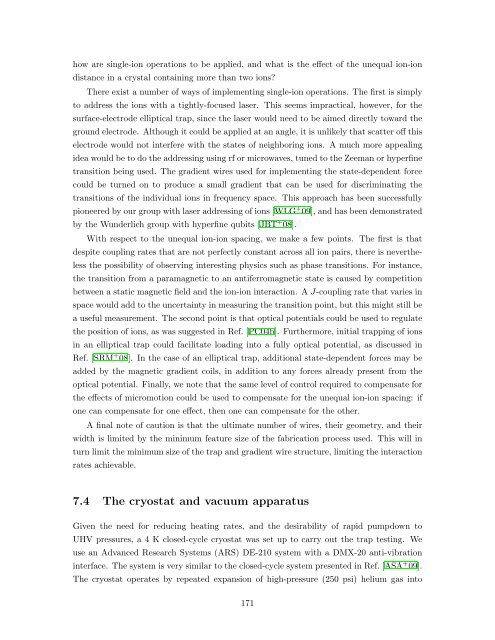Ph.D. Thesis - Physics
Ph.D. Thesis - Physics
Ph.D. Thesis - Physics
Create successful ePaper yourself
Turn your PDF publications into a flip-book with our unique Google optimized e-Paper software.
how are single-ion operations to be applied, and what is the effect of the unequal ion-ion<br />
distance in a crystal containing more than two ions?<br />
There exist a number of ways of implementing single-ion operations. The first is simply<br />
to address the ions with a tightly-focused laser. This seems impractical, however, for the<br />
surface-electrode elliptical trap, since the laser would need to be aimed directly toward the<br />
ground electrode. Although it could be applied at an angle, it is unlikely that scatter off this<br />
electrode would not interfere with the states of neighboring ions. A much more appealing<br />
idea would be to do the addressing using rf or microwaves, tuned to the Zeeman or hyperfine<br />
transition being used. The gradient wires used for implementing the state-dependent force<br />
could be turned on to produce a small gradient that can be used for discriminating the<br />
transitions of the individual ions in frequency space. This approach has been successfully<br />
pioneered by our group with laser addressing of ions [WLG + 09], and has been demonstrated<br />
by the Wunderlich group with hyperfine qubits [JBT + 08].<br />
With respect to the unequal ion-ion spacing, we make a few points. The first is that<br />
despite coupling rates that are not perfectly constant across all ion pairs, there is neverthe-<br />
less the possibility of observing interesting physics such as phase transitions. For instance,<br />
the transition from a paramagnetic to an antiferromagnetic state is caused by competition<br />
between a static magnetic field and the ion-ion interaction. A J-coupling rate that varies in<br />
space would add to the uncertainty in measuring the transition point, but this might still be<br />
a useful measurement. The second point is that optical potentials could be used to regulate<br />
the position of ions, as was suggested in Ref. [PC04b]. Furthermore, initial trapping of ions<br />
in an elliptical trap could facilitate loading into a fully optical potential, as discussed in<br />
Ref. [SRM + 08]. In the case of an elliptical trap, additional state-dependent forces may be<br />
added by the magnetic gradient coils, in addition to any forces already present from the<br />
optical potential. Finally, we note that the same level of control required to compensate for<br />
the effects of micromotion could be used to compensate for the unequal ion-ion spacing: if<br />
one can compensate for one effect, then one can compensate for the other.<br />
A final note of caution is that the ultimate number of wires, their geometry, and their<br />
width is limited by the minimum feature size of the fabrication process used. This will in<br />
turn limit the minimum size of the trap and gradient wire structure, limiting the interaction<br />
rates achievable.<br />
7.4 The cryostat and vacuum apparatus<br />
Given the need for reducing heating rates, and the desirability of rapid pumpdown to<br />
UHV pressures, a 4 K closed-cycle cryostat was set up to carry out the trap testing. We<br />
use an Advanced Research Systems (ARS) DE-210 system with a DMX-20 anti-vibration<br />
interface. The system is very similar to the closed-cycle system presented in Ref. [ASA + 09].<br />
The cryostat operates by repeated expansion of high-pressure (250 psi) helium gas into<br />
171
















